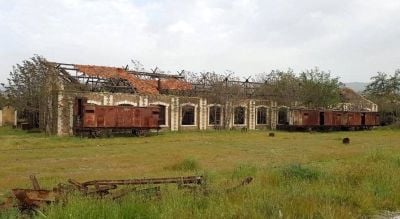A building of Rayak's foundry. photo Joëlle Khoury Aouad
Train/Train Lebanon is trying to restore the train system in Lebanon and organized a weekend of festivities, including a concert and a photo exhibition by Eddy Choueiri and a painting exhibition by Tom Young, to commemorate the anniversary of the railway. The event took place on Aug. 10 and 11 at the foundry in Rayak and included a visit to the train station at the old Mar Mikhael-Rayak track. Seven hundred people came during the two days.
Train/Train Lebanon consists of about 60 people who campaign to preserve Lebanon’s railway heritage and to make the train system functional again. "The train is a democratic economic and social tool that can help revitalize Lebanon. It is economical because it will enable businesses, especially factories, to transport their goods; it is social because it can offer the Lebanese people the opportunity to discover their country at a lower cost and to meet their fellow citizens from other communities and regions; finally it is democratic because it is accessible to all," Naffah said.
The organization was founded in 2005 and has organized guided tours of old Lebanese railway stations and Rayak’s foundry over the years.
In the past, the railroad helped Rayak thrive and grow prosperous. The city housed the largest foundry and the most important railway workshops in the area. All of the trains that operated in a territory that stretched to Istanbul used to come to the town for maintenance. The industry sustained more than 1,500 jobs, from railway directors to technicians working in the foundry and repair shops.
Assaad Namroud, now 92 years old, started out as a simple railway worker, following in his father’s footsteps, and eventually became a conductor. "My train was the most beautiful one. I took good care of it. It used to shine under the sun when it entered the station. Everyone noticed it when it arrived,” Namroud recalled proudly.
"I also remember that in Syria there were regular state coups. Often when arriving in or leaving Damascus, I would be afraid because soldiers were deployed. One day, I was very scared when I came back to Rayak, and I dreaded returning to Damascus. A few hours before my departure for the Syrian capital, the management decided to suspend the trips until the situation calmed down. That was when Hosni al-Zaim came to power through a coup in March 1949,” he adds.
The train station in Mar Mikhael was the starting point for the Beirut-Damascus line, which went from the coast, across the heights of Mount Lebanon and ended in Damascus.
The train was a product of the industrial revolution and was first created to transport goods, which was its main purpose in Lebanon when the railway was first built. During the Ottoman empire, it was necessary to connect Damascus to the coast. Beirut, with its brand new port, benefited from the project, which was carried out by the French. The British wanted to build a railway between Jaffa and Damascus to bypass the Beirut line, but the project was never carried out.
The Beirut-Damascus line was built on behalf of the Ottoman Empire as part of a privilege granted to the French in 1891 and connected the two cities via Rayak. Specially designed tracks were laid in Baabda to scale Lebanon’s mountains. They pulled the train all the way to Dahr el-Baidar where, in the winter time, the locomotives were equipped with snow plows to push through the harsh mountain weather.
Military Line
Villages, such as Sofar, were built around train stations. With casinos and hotels located close to the stations, they became summertime resort destinations for visitors from across the region, including Palestine and Egypt.
The Beirut-Rayak-Damascus line has narrow tracks and is 147 kilometers long, 77 kilometers of which are in Lebanese territory. The stations were built by the French. The rails and equipment were from Belgium. And the steam locomotives were Swiss. A second line, commissioned in 1902, connected Rayak to Baalbek. A few years later it was extended to Homs.
Following Beirut, a commercial railway was built in the port of Tripoli. Starting in June 1911, the line connected Tripoli to Homs, but it did not last long. During World War I, Ottoman troops tore the rails off the tracks, looted the stations and confiscated the equipment that was being used to construct a route linking Damascus and Baghdad, which had significant military importance.
In 1942, a railway line running along the coast between Beirut and Tripoli was constructed and inaugurated by Australian soldiers who were in Lebanon during World War II. The line was used to transport soldiers and military equipment. The same year, another line connecting Beirut to Haifa was also built and inaugurated by soldiers from New Zealand and was used for the same purposes. After the war, the line was used for commerce, but it did not operate for long. In 1948, shortly after the creation of the State of Israel, the tunnels at the end of the Tripoli-Naqoura line were destroyed.
By 1961 the railway network was owned and managed by the Lebanese state, which was in a golden era of infrastructure and luxury tourism. Highways replaced the railroad, and the car became the preferred mode of transportation. Little by little, trains declined in popularity and eventually stopped running altogether during the Lebanese civil war.
In 1976, Namroud became the last conductor to drive a train on the Beirut-Rayak line. "The war had just broken out, and it was getting harder and harder to get around by train. One night, I got on my train in Rayak only to be informed that management had suspended work until further notice," he said.
A few months later, Rayak's huge workshop was occupied by the Syrian Army, and Namroud’s train never whistled again.
(This report was originally published in French in L'Orient-Le Jour on the 14th of August)
